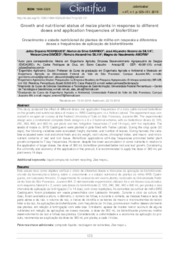Growth and nutritional status of maize plants in response to different doses and application frequencies of biofertilizer.
Growth and nutritional status of maize plants in response to different doses and application frequencies of biofertilizer.
Author(s): RODRIGUES, J. S.; GARRIDO, M. da S.; SILVA, J. A. B. da; SIMOES, W. L.; SILVA, R. A.; AMORIM, M. do N.
Summary: This study analyzed the effect of different doses and application frequencies of a dairy cattle-derived biofertilizer on the growth and nutritional status of maize cv. BRS Caatingueiro in a Yellow Latosol. The experiment was con-ducted in an open-air nursery at the Federal University of Vale do São Francisco, Juazeiro-BA. The experimental design was a randomized complete block design in a 6 x 2 factorial scheme, with six biofertilizer doses (0, 120, 240, 360, 480, and 600 mL per plant) and two fertigation frequencies (7 and 14 days), with five replicates. The seeds of maize cv. BRS Caatingueiro were planted in pots filled with Yellow Latosol. During the crop cycle (90 days), the following variables were evaluated: height, diameter, and number of leaves. During harvest, the varia-bles evaluated were: root and shoot fresh and dry weight, root volume, chlorophyll index, and macro- and micro-nutrient contents of leaf and root tissue. Biofertilizer applications at14-day frequencies promoted better plant growth compared to 7-day frequencies. However, despite the lower accumulation of some nutrients in relation to the application of larger doses, the dose of 360 mL biofertilizer promoted better root and leaf growth. Considering the uniformity and economy of the application of the product, it is recommended to apply the dose of 360 mL per plant every 14 days.
Publication year: 2019
Types of publication: Journal article
Unit: Embrapa Semi-arid Region
Keywords: Biofertilizante, Composto líquido, Milho, Reciclagem de nutrientes, Zea Mays
Observation
Some of Embrapa's publications are published as ePub files. To read them, use or download one of the following free software options to your computer or mobile device. Android: Google Play Books; IOS: iBooks; Windows and Linux: Calibre.
Access other publications
Access the Agricultural Research Database (BDPA) to consult Embrapa's full library collection and records.
Visit Embrapa Bookstore to purchase books and other publications sold by Embrapa.

